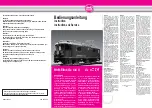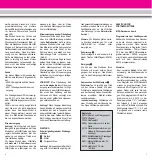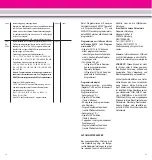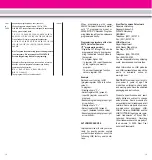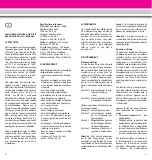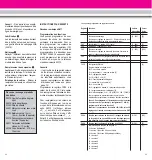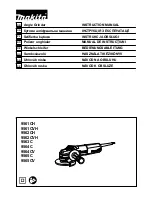
RhB Ge 4/4 II Electric Loco
THE PROTOTYPE
To replace older electric locomotives
of the types Ge 2/4, Ge 4/6 and Ge
6/6 I, the Rhätische Bahn (RhB) in
1970 ordered ten modern four-axle
locomotives with thyristor controls.
The locos were delivered in 1973 and
numbered 611-620. With their cut-
ting-edge electronics, the locomo-
tives immediately were a great suc-
cess. In 1984/85, the RhB received
another 13 identical locomotives.
These first true multi-purpose elec-
tric locos of the RhB quickly took
over the express train duties on the
difficult Albula line from Chur to St.
Moritz. Today, the Ge 4/4 II has
proven its worth hauling every type
of train from express passenger to
local freight service. Since the Arosa
line has been converted from DC to
the same AC current as the main RhB
network, all trains between Chur and
Arosa have been hauled by Ge 4/4 II,
including the Arosa Express on its
daily run through the bucolic land-
scape of the Engadin.
For a few years, the RhB has
replaced the original round lower
lights with standard square ones.
The LGB model is a replica of the Ge
4/4 II in this modernized version.
Technical specifications
Wheel arrangement: BoBo
Gauge: 1000 mm (39.4 in)
Length over buffers: 2,960 mm
(42.5 ft)
Width: 2650 mm (8.69 ft)
Operating weight: 50.0 metric tons
(110,000 lbs)
Pulling power: 185 metric tons
(407,000 lbs/4.5% grades), 245
metric tons (539,000 lbs/3.5%
grades)
Max. speed: 90 km/h (56 mph)
THE MODEL
This detailed model features:
- weather-resistant construction
- factory-installed onboard decoder
for MTS and analog operation
- opening cab doors
- two power control switches
- track or catenary power operation
- two protected gearboxes with
seven-pole Bühler motors
- eight powered wheels
- one traction tire
- twelve power pickups
- two automatic pantographs
- voltage stabilization circuit with
surge protection
- automatic directional lighting
(exterior and interior)
- two multi-purpose sockets with
circuit breakers
- length: 570 mm (22.4 in.)
- weight: 4200 g (9.2 lb.)
THE PROGRAM
This LGB model is part of the com-
prehensive LGB program of more
than 600 quality G-scale trains, track
sections and accessories. To learn
more about the many other products
in the LGB program, see the big LGB
catalog or visit www.lgb.com
OPERATION
Operating Modes
This model can be operated with
track power or with power from an
LGB catenary system. There are two
power control switches located in the
cab with the engineer (Fig. 1). Use
the upper switch to select track or
catenary power (Fig. 2):
Position U: track power (factory pre-
set)
Position O: catenary power
Use the lower switch to select among
the following functions:
Position 0: All power off
Position 1: Power to lights and
pantograph control
Position 2: Power to motors, lights
and pantograph control
Position 3: Same as Position 2
(factory pre-set)
Attention: Do not connect this model
to other loco models with different
starting characteristics. This can
damage the internal gearing.
Hint: This model is equipped with a
starting delay circuit. This enables
the model to move the pantographs
up and down while it is stopped.
Multi-Train System
The model is equipped with a facto-
ry-installed onboard decoder for the
LGB Multi-Train System. It can be
used without modifications on ana-
log or digital layouts. For operation
with the Multi-Train System, the
model is programmed to loco
address 03. For information on pro-
gramming the loco address, see the
instructions for various MTS compo-
nents.
When operating with the Multi-Train
System, you can remotely control the
loco’s functions. Press the lighting
button (“9” with remotes) to turn the
loco lights on or off. Press the func-
tion buttons to control the following
functions:
3: Raise/lower pantographs
7: Change pantograph settings: rear
pantograph up/both pantographs
up (The new settings will be saved
even if power is turned off)
With a Loco Remote or Universal
Remote, press the numbered loco
function buttons. For example, to
raise or lower the pantographs, press
button “3” on the Loco Remote or
Universal Remote.
When using the MTS components
marked with a “p,” this loco can
receive "parallel" function com-
mands, which eliminate the pause
that occurs when a "serial" command
is received.
Parallel: Command is send directly.
Serial: Command is send as a string
of "1" commands, for example,
3 = 1 + 1 + 1).
Most MTS components can be
upgraded to parallel function com-
mands (Exceptions: first generation
55000 MTS Central Station, 55010
Train Mouse). For more information,
contact your authorized retailer or go
to www.lgb.com.
When operating with the Multi-Train
System, the loco features a “Back-
EMF” function. This keeps the motor
speed constant (and under normal
conditions the loco speed), even
when the load of the loco changes,
for example, in curves or on grades.
This feature does not work at top
speed, because additional voltage
must be available to overcome any
added load.
If desired, numerous functions of the
onboard decoder, such as accelera-
tion, braking, direction of travel and
many others, can be programmed
using a PC and the 55045 MTS PC
Decoder Programming Module (see
Instructions for advanced users).
These functions also can be pro-
grammed with the 55015 Universal
Remote.
13
12
GB
USA

